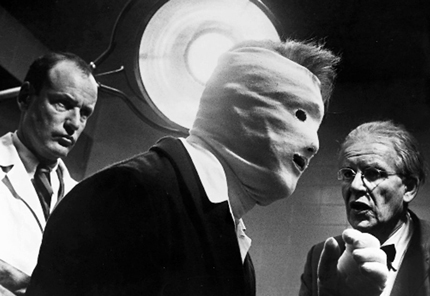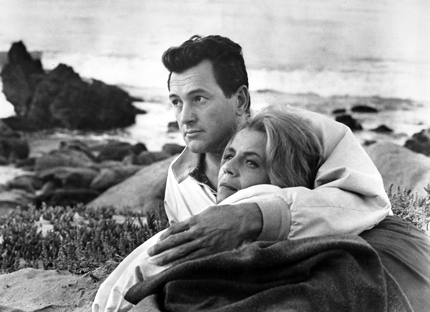
 |
|
|
|
John Frankenheimer's paranoid thriller Seconds was made about five years too soon. What might at first glance seem an over-extended Twilight Zone episode is actually more profound than most European art films of the time. When new it suffered from its very originality: American audiences weren't looking for its blend of mystery and horror, and they certainly didn't take to seeing their matinee idol Rock Hudson cast against type. Mostly ignored in 1966, Seconds' critical reputation has been growing ever since. The movie begins amid distorted images that reflect the subjective disappointment and disillusion of its middle-aged protagonist. Lost in a dull existence, banker Arthur Hamilton is shocked to hear the voice of a dead friend on the phone. He is invited to reinvent his own life through the services of a secret company. Arthur takes the bait and transfers the bulk of his fortune into the company's hands. His own death is faked. Futuristic medicine and plastic surgery plus therapy and coaching transform him into a much younger-looking man who goes by the name Tony Wilson (Rock Hudson). Leaving his widow (Frances Reid) behind, 'Tony' is set up as a trendy Malibu artist with a full fake background and a 'seeded' client list. All goes well at first, including a meeting with a sexy beach denizen named Norma Marcus (Salome Jens). But Tony soon finds himself slowly reverting to Arthur's pensive, apprehensive state of mind. Norma's hedonistic friends intimidate him, when he should feel liberated. Worst of all, Arthur/Tony is tempted to make contact with the life he left behind -- an action forbidden by his deal with "the company". 
John Frankenheimer pioneered the '60s paranoid thriller with the superlative The Manchurian Candidate and the tense Seven Days in May. After his thematic break into WW2 action with The Train, Frankenheimer created this intricate concoction that shrinks his previous conspiracies down to the intimate level. Author David Ely's story is a science-fiction Faust. Our hero sells his soul not to the devil but to a soulless corporation, for the ultimate consumer product, the ability to restart his life again in a new identity. It's a carrot so tempting that Arthur never questions the details, such as what that the room full of bored men waiting by telephones is all about, or where exactly the bogus body comes from to fake his death. Arthur Hamilton is disenchanted and alienated, drifting in a quiet nightmare of sameness and meaningless daily life, ruminating over his youth and ideals and wondering what went wrong. He compounds his grief with the belief that he can somehow start again and leave his previous self behind. This earlier part of the film is nothing short of brilliant. John Randolph projects the petty problems of a modern pod person with perfect pitch. He conveys Arthur's lack of an inner light, a spiritual beacon, very clearly. Instead of looking for the answer within, Hamilton tries to buy his dreams. The secret company that provides the secret services makes use of fantastic medical technology, but we're just as impressed by their sophisticated security safeguards. Farfetched to the point of absurdity, the company undertakes its business with stringent secrecy and uses careful blackmail to protect itself. We also become aware of a vast covert operation to fake new lifestyles for the clients embarking on a second life, aka 'seconds'. The story neatly sidesteps the obvious impossibility of keeping such a vast conspiracy secret. The second half of Seconds puts Arthur/Tony through the wringer with a brutal irony. We've seen the story before but in different forms and genres. Steve Sekely's Hollow Triumph (The Scar) is a film noir with a 'trick' plot that we accept only because it creates some interesting, exciting situations. A psychiatric-trained master thief runs into a real psychiatrist who looks just like him, an identical double. This patently ridiculous coincidence allows the thief to undergo a change of identity. What makes Hollow Triumph function, of course are the further plot complications that put the thief in a worse predicament than he faced before. 
Saggy, soulful John Randolph becomes the handsome hunk 'mesomorph' Rock Hudson, the man he claims he wants to be. It's the film's most difficult hurdle. Hudson's interpretation of the part is very impressive, but the transformation is a big leap of faith for the audience. It makes perfect sense that Arthur/Tony would soon begin to revert to his previous feelings of disenchantment, even though the company has set him up in this ideal life situation. When Arthur/Tony realizes that many (or all?) of the people he is meeting may be employees of the company, or worse, other 'seconds', Frankenheimer successfully elbows in on Invasion of the Body Snatchers territory. Graced by the sensational visual moods of cameraman James Wong Howe, the movie excels at creating a first-person paranoid experience. 1 The lowly Hammer horror film Frankenstein Must Be Destroyed is about a brain transplant. The colorful musical Damn Yankees is a straight Faust story. In each a husband's consciousness is transferred to a new body, and in each the husband is compelled to seek out the wife he left behind. Seconds has more psychological depth than either of those films, but it maintains at an unemotional distance. We've built up a strong desire to become emotionally involved in Rock Hudson's predicament, but the movie is more about the trap than the prey... the more Hudson struggles against things he cannot control, the more we become convinced he's a doomed guinea pig, in a maze with one exit. Hudson's reactions are those of a dullard with no imagination. If Arthur/Tony is that big of a nothing, then our only reaction is to stop caring what happens to him. Where Seconds soars is in its stylistic visuals. James Wong Howe's fisheye lens distortions of the hero's ghost world conjure feelings of insect-like alienation, very effectively evoking our participation in Arthur's journey. In 1966, the only similar consistent look was to be found in experimental movies like Maya Deren's Meshes in the Afternoon. Frankenheimer and Howe's exacting, painstaking visuals are as technically sophisticated as could be for that time; several of the cameramen I knew in the '70s held Seconds as their favorite artistic film for cinematography. Frankenheimer populates Seconds with familiar faces and former blacklistees like Will Geer and Jeff Corey; John Randolph had been kept from film work for ten full years. Murray Hamilton is excellent as Hudson's connection to the company. Salome Jens plays one of the few convincing Earth-mother free spirits in '60s movies. 2 Her Norma Marcus is intimate, sexy, and exhibits typical Malibu Mama behaviors like shouting personal messages to the ocean. We like her that way and resent it when the story pulls the rug out from under her character. 
In 1996 Paramount lengthened Seconds by restoring an original, more racy cut of the scene at the Santa Barbara wine fair. It may confuse those who saw the film's domestic release, which could never have contained this content. The nude scenes were found intact on a negative for French export. But the French censors cut a scene in which Rock Hudson is given fake credentials for his new persona as a high-toned artist, including a counterfeit diploma from the Sorbonne. Apparently the French censor wasn't bothered by the full-frontal nudity, but couldn't abide the affront to the integrity of the Sorbonne. Criterion's Blu-ray of Seconds far outclasses Paramount Home Video's DVD release from 2002. The image is visual perfection, far sharper and much cleaner than that older transfer. Saul Bass's title sequence films facial close-ups through distorting glass and lenses, and is truly disturbing. We also appreciate Jerry Goldsmith's carefully modulated music score, which builds mystery and tension on an almost subliminal level. Disc producer Susan Arosteguy has created an excellent group of extras. John Frankenheimer's feature commentary comes from the 1997 Paramount laserdisc. 3 Alec Baldwin's 14-minute piece describes working with the director. The director's widow Evans (Evans) Frankenheimer hosts a longer look at the film's production, with additional input from Salome Jens, who describes the filming of the daring wine festival scene. R. Barton Palmer and Murray Pomerance narrate a visual essay on Seconds. Frankenheimer appears in a 1971 TV interview, and the director, cinematographer Howe and star Hudson are seen filming in New York in an interesting full-color 1965 TV excerpt. The insightful insert booklet essay is by David Sterritt. The only thing missing that can be seen on the older DVD is an original trailer.
On a scale of Excellent, Good, Fair, and Poor,
Seconds Blu-ray rates:
Footnotes:
1. A good case can be made for Seconds being a critique of self-perpetuating corporations that must continue to roll forward and make a profit, no matter what happens. Since profit and self-preservation are what drives a company, this one must victimize the very customers it claims to serve. That's a lot like companies that yield to the expediency of releasing dangerous products, because recalling them might hurt the bottom line.
2. A bad one? Liz Taylor as the bohemian free spirit of Big Sur in The Sandpiper. 3. Commentary source corrected, thanks to correspondent Steve Grimes, July 30, 2013: Mr. Savant, I enjoyed your review of Criterion's new Blu-Ray of Seconds. As usual your analysis provides welcome context as well as well-written opinion. The smallest of nits to pick: the John Frankenheimer audio commentary in fact first appeared on the 1997 laserdisc release. This was also when the alternate "European" cut first made its appearance. I've seen other reviewers also claim that the commentary originates from the DVD release, and while I can readily admit it doesn't matter in the grand scheme of things, it's something I apparently can't let go of.
Keep up the good work. I look forward to your new reviews every week. You have turned me onto countless films I perhaps never would have gotten around to seeing on my own, so for that I thank you. --Steve Grimes.
Reviews on the Savant main site have additional credits information and are often updated and annotated with footnotes, reader input and graphics.
Review Staff | About DVD Talk | Newsletter Subscribe | Join DVD Talk Forum |
| ||||||||||||||||||